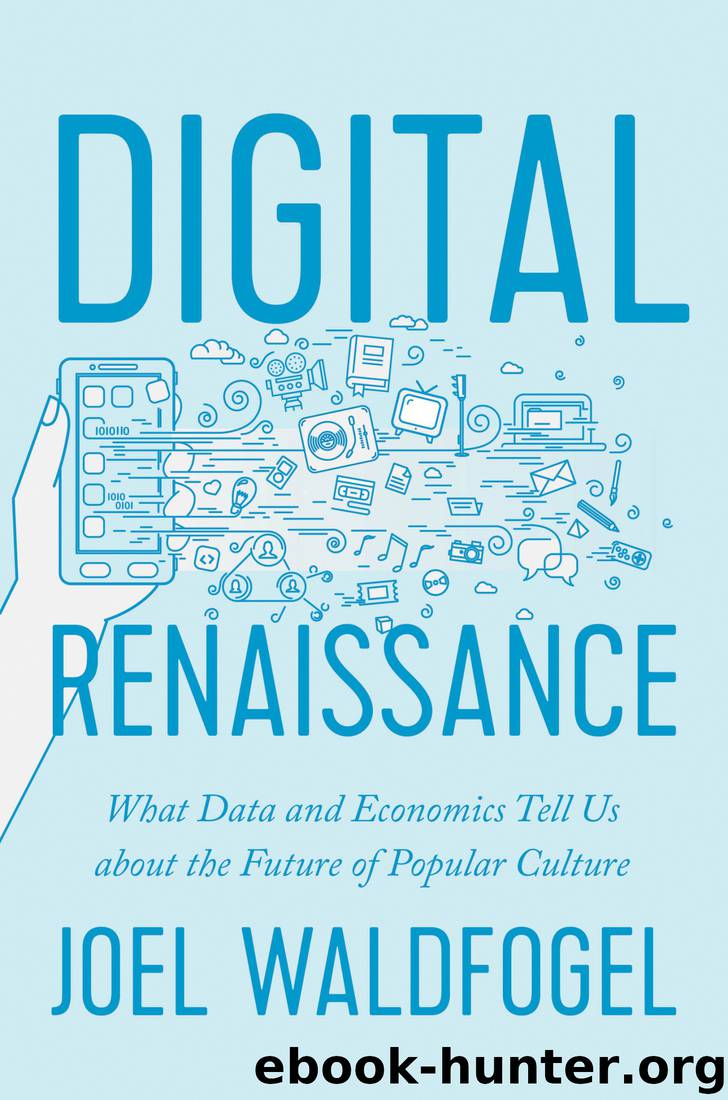Digital Renaissance: What Data and Economics Tell Us About the Future of Popular Culture by Joel Waldfogel

Author:Joel Waldfogel [Waldfogel, Joel]
Language: eng
Format: epub
Tags: Business & Economics, Economics, General, Industries, Media & Communications, Consumer Behavior, Entrepreneurship
ISBN: 9780691162829
Google: GmuYDwAAQBAJ
Amazon: 0691162824
Publisher: Princeton University Press
Published: 2018-11-13T00:00:00+00:00
What the Data Tell Us
Anecdotes are all well and good. But what about data? What has actually happened to the photography industry? As amateurs have entered the photography business, what has happened to the number of professional photographers? According to the Bureau of Labor statistics, the number of persons working as photographers fell from 66,000 in 1999, to 56,000 in 2012, to 48,600 in 2016.30 The number of establishments selling photograpers’ services in the United States fell from a high of 19,600 in 2007, to 17,500 in 2011, to 17,167 in 2013.31 Professional photographers are in retreat.
And what about the pictures, as opposed to the people creating them? Let’s ignore Instagram for a moment and focus on commercial images. Despite the reduction in the number of professional photographers and the businesses specializing in photography, the number of images available for commercial use has grown substantially. The two largest sources of stock images are Getty and Corbis. The images at Getty are indexed by the year they were originally shot. Using the advanced search feature of the Getty website, one can query all of the creative stock and editorial images created between, say, January 1, 1960 and December 31, 1960. The result: 76,248. By doing this query for every year since 1960, we see a pattern emerge. Between 1960 and the late 1990s, there are about 50,000 images per year. Thereafter the number of new images from each vintage rises quickly, passing 1 million for 2002 and 5 million for 2009. In 2012–2014, Getty’s stock increased by more than 7 million new images per year. In short, the number of professional photographers is falling, but the number of new photographs being made available has risen sharply.
Prices have fallen with the growth in supply. Getty now operates both Getty Images, which licenses pictures by professional photographers, as well as iStock, a library of images made by a wide range of photographers, including amateurs. At Getty, “standard editorial rights,” including fifteen years of worldwide use and a large (25 mB) image, cost $575 in 2017.32 At iStock, a “standard license” allowing use of a high-resolution image for “content in advertising, marketing, apps, websites, social media, TV and film, presentations, newspapers, magazines and books, and product packaging” goes for $12.33
If you think that what amateurs are doing to professional photographers today is unfair, consider what photography did to painting 150 years earlier. In 1839, Louis Daguerre invented a rudimentary camera in Paris. When he saw his first daguerreotype, painter Paul Delaroche declared, “From today painting is dead.” Polymath Samuel F. B. Morse, an accomplished painter as well as an anti-immigrant politician and the inventor of the telegraph and Morse code, was also impressed by Daguerre’s invention.34 Referring to the prints as “Rembrandt perfected,” he turned away from painting and established a daguerreotype studio in New York. Technological change is challenging for incumbents, and the digitization of photography is no exception.
With nearly 100 million shots a day on Instagram, there must be some good ones.
Download
This site does not store any files on its server. We only index and link to content provided by other sites. Please contact the content providers to delete copyright contents if any and email us, we'll remove relevant links or contents immediately.
| Advertising | Consumer Behavior |
| Customer Service | Marketing |
| Public Relations | Sales & Selling |
| Search Engine Optimization |
Influence: The Psychology of Persuasion by Robert B. Cialdini(4715)
The Miracle Morning by Hal Elrod(4637)
The Hacking of the American Mind by Robert H. Lustig(4318)
Pre-Suasion: A Revolutionary Way to Influence and Persuade by Robert Cialdini(4144)
Unlabel: Selling You Without Selling Out by Marc Ecko(3587)
Ogilvy on Advertising by David Ogilvy(3504)
Hidden Persuasion: 33 psychological influence techniques in advertising by Marc Andrews & Matthijs van Leeuwen & Rick van Baaren(3472)
Purple Cow by Seth Godin(3138)
Who Can You Trust? by Rachel Botsman(3086)
Kick Ass in College: Highest Rated "How to Study in College" Book | 77 Ninja Study Skills Tips and Career Strategies | Motivational for College Students: A Guerrilla Guide to College Success by Fox Gunnar(3072)
The Marketing Plan Handbook: Develop Big-Picture Marketing Plans for Pennies on the Dollar by Robert W. Bly(2975)
This Is Marketing by Seth Godin(2970)
I Live in the Future & Here's How It Works by Nick Bilton(2935)
The Power of Broke by Daymond John(2897)
Building a StoryBrand by Donald Miller(2841)
The Tipping Point by Malcolm Gladwell(2827)
The 46 Rules of Genius: An Innovator's Guide to Creativity (Voices That Matter) by Marty Neumeier(2796)
Draw to Win: A Crash Course on How to Lead, Sell, and Innovate With Your Visual Mind by Dan Roam(2733)
Market Wizards by Jack D. Schwager(2643)
